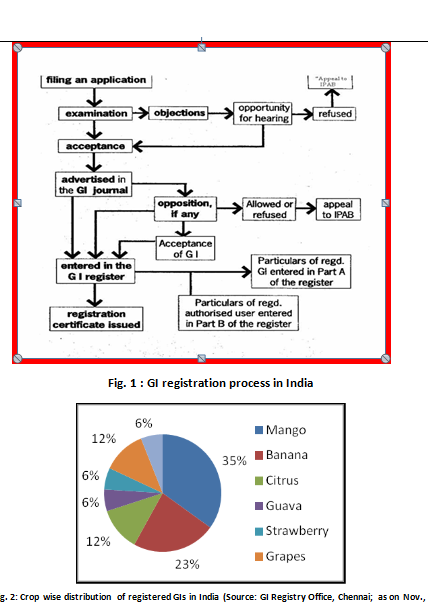Authors: Praveen Kumar Mishra1*, Ravindra Kumar Singh1 and Sanjay Sahay2
praveen.bau@gmail.com*
1. Ph. D. Scholar*
2. Associate Professor cum Senior Scientist
Department of Horticulture (Fruit & Fruit Technology), B.A.U., Sabour, Bhagalpur, Bihar, India, 813210.
Introduction
Geographical indication (GI) is an indication utilizes the produces for particular geography due to their popularity and original home. Some agricultural, horticultural and manufactured goods have natural speciality because of several aspects such as production site, soil and microclimate. Geographical indication may be used broadly to conserve and protect various fruit products for our society’s future. A several fruit cultivars are known to produce unique characteristics (aroma & flavour) only due to specific zone of climatic situations. Geographical indication registration gives authentic and lawful permission for agricultural, natural and manufactured goods under GI in India. The Geographical Indication of Goods (Registration and protection) Act 1999 can prevent the unauthorized use of registered GI by the others, boosting export of the Indian GIs, promotes economical prosperity of producers and also permit looking for authorized protection in other associated countries of WTO. India is rich in natural horticultural goods especially in fruits. Some fruit cultivars had already popularized its home and also registered under Geographical Indication of Goods (Registration and protection) Act 1999 with individual geographical names which are listed in Table-1. A lot of other fruit produces are remain in all over India so need to their conservation and registration for developing some other promising cultivars for present as well as future economic prospective of mankind. This act provides rights to locality for unauthorized use registered geographical indication by others and avail economic prosperity of producers of goods produced in a geographical territory.
Table 1: Fruit crops registered under GI tag in India
| Sr. No. | Geographical Indications | States |
| 1. | Coorg Orange | Karnataka |
| 2. | Banana Nanjanagud | Karnataka |
| 3. | Allahabad Surkha Guava | U.P. |
| 4. | Eathomozhy Tall Coconut | Tamilnadu |
| 5. | Laxman Bhog Mango | West Bengal |
| 6. | Khirsapati (Himsagar) Mango | West Bengal |
| 7. | Fazli Mango (Malda) | West Bengal |
| 8. | Virupakshi Hill Banana | Tamilnadu |
| 9. | Sirumalai Hill Banana | Tamilnadu |
| 10. | Mango Malihabadi Dusseheri | Uttar Pradesh |
| 11. | Vazhakulam Pineapple | Kerala |
| 12. | Devanahalli Pomello | Karnataka |
| 13. | Appemidi Mango | Karnataka |
| 14. | Kamalapur Red Banana | Karnataka |
| 15. | Mahabaleshwar Strawberry | Maharashtra |
| 16. | Nashik Grapes | Maharashtra |
| 17. | Gir Kesar Mango | Gujrat |
Legal aspects and procedure
The geographical indication is generally possessed by a community that represents the particular good at particular location. An individual person can not apply for GIs but representative person of any association, organization and producers can apply for GIs in India. Before that no split legislation on GIs was present for registration of fashionable fruit produces. GIs Act 1999 has come in existence from 15th September 2003 and Central Government has also established the “Geographical Indication Registry” by the all jurisdictions at Chennai, as per the GI of Goods (Registration and Protection) Act 1999. The protection period of geographical indication is unlimited but the renewal is required after every ten years.

Conclusion
Geographical Indications is slowly gaining prominence in India. Due to diverse Indian agro climatic conditions, we have large number of fruit cultivars with special characters which are distinct from other countries. Till date there are 17 registered fruit cultivars with G.I status and many more is follows in years to come. However, there is an urgent need to aware the community/farmers about the importance of GI for their economic prosperity and larger benefits.
References:
• Das, Kasturi (2009), Socioeconomic Implications of Protecting GIs in India, WTO Centre, IIFT, New Delhi.
• Nikhil, D. and Harit, M. (2012). The Status of Geographical Indications in India: A Short Review, Intellectual property division, Stellarix Consultancy Services Pvt. Ltd.
• Rani, M.U. and Kumar, M.K. (2013). Geographical indications in fruit crops - A review. Ind. J. of Res., 3(5):148-149.
About Author / Additional Info:
Ph. D. Scholar in Fruit Science at BAU Sabour, Bhagalpur, Bihar